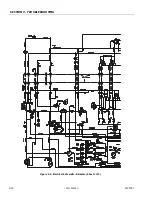
SECTION 2 - PROCEDURES
2-30
– JLG Sizzor –
3120791
13.
Turn P8, drive reverse low, clockwise until the
wheels just start to move. The ammeter should read
about 0.4 Amps or 400 mA. This value is approxi-
mate, the reading will be slightly different from one
machine to another.
NOTE: Adjusting the low setting affects the high. Adjusting
the high setting does not affect the low. If you have to
re-adjust the low after the high is set, you must re-
check the high, the decel, and the accel settings.
14.
With drive reverse still full on, set P7, drive reverse
high. Turn P7 clockwise until the ammeter reads 1.1
Amps or 1100 mA. DO NOT TURN ANY HIGHER!
The valve will draw more current but no additional
speed will be gained and the acceleration and
deceleration will not work properly.
15.
Next, set P6, drive reverse deceleration. Turning P6
clockwise increases the time. Turn the pot approxi-
mately 15 turns and test by energizing drive reverse,
stroking the joystick to full on, then letting go. It
should take about 3 seconds for the drive wheels to
stop. Adjust P6 to obtain 3 seconds.
16.
Next, set P5, drive reverse acceleration. Turning P5
clockwise increases the acceleration. Turn the pot
approximately 15 turns and test by going from no
drive to full on drive reverse, then timing how long it
takes until the meter reads 1.1 A or 1100 mA. It
should take about 5 seconds. Adjust P5 to obtain 5
seconds.
Horsepower Card Test
Before starting this procedure, all hydraulic relief pressure
settings and engine RPM settings should be set, and the
engine warmed to operating temperature. Refer to Figure
2-23., Valve Driver Card.
A voltmeter will be required to perform the test.
1.
Elevate the drive wheels and support them securely.
2.
Start the engine from the ground control station.
3.
Activate high engine. High engine speed must be
greater than 3100 rpm.
4.
Measure the voltage from ‘L’ to ‘MO’ by putting the
voltmeter’s red lead on “L” and the black lead on
“MO.” These are the only two test points available
on the horsepower card.
5.
If the voltmeter displays 1.98 volts dc or greater, the
horsepower card is operational and the test is com-
plete.
6.
If the voltage is between 1.90 volts dc and 1.97 volts
dc and the engine is above 3100 rpm, manually
increase the engine rpms and monitor the voltage.
If the voltage does not increase above 1.98 volts dc, the
horsepower card is operational and the test is complete.
If the voltage does increase above 1.98 volts dc, replace
the horsepower card.
7.
If the voltage is below 1.90 volts dc but greater than -
1.0 volts dc, replace the horsepower card.
8.
If the voltage is below -1.0 volts dc, verify the wiring
between the engine and the horsepower card is
properly terminated. If the wiring is okay, replace the
horsepower card.
Summary of Contents for 26MRT
Page 2: ......
Page 11: ...SECTION 1 SPECIFICATIONS 3120791 JLG Sizzor 1 5 Figure 1 2 Serial Number Locations ...
Page 12: ...SECTION 1 SPECIFICATIONS 1 6 JLG Sizzor 3120791 Figure 1 3 Torque Chart ...
Page 28: ...SECTION 2 PROCEDURES 2 16 JLG Sizzor 3120791 Figure 2 16 Drive Axle Assembly ...
Page 37: ...SECTION 2 PROCEDURES 3120791 JLG Sizzor 2 25 Figure 2 20 Brake Assembly ...
Page 40: ...SECTION 2 PROCEDURES 2 28 JLG Sizzor 3120791 Figure 2 22 ADDCO Adjustments Diesel Engine ...
Page 58: ...SECTION 3 TROUBLESHOOTING 3 14 JLG Sizzor 3120791 Figure 3 5 Hydraulic Schematic Sheet 1 of 2 ...
Page 60: ...SECTION 3 TROUBLESHOOTING 3 16 JLG Sizzor 3120791 This page intentionally left blank ...
Page 61: ......
































